HR Economics: Pay-Performance Structure and Efficiency Wage Theory
VerifiedAdded on 2020/04/29
|14
|3149
|35
Essay
AI Summary
This essay examines the relationship between employee pay and performance within organizations, emphasizing the role of project completion and job performance in determining rewards. It provides an overview of the objectives, goals, and functions of Australia's Fair Work Commission (FWC), an independent body overseeing employment-related matters. The essay delves into the efficiency wage theory, explaining its application and potential issues in firms, alongside an analysis of general labor supply and the backward-bending supply curve. The study highlights how companies like SG Company implement efficiency wage strategies to improve performance, attracting skilled employees and boosting productivity. It also discusses the pay-performance structure, its issues, and the challenges faced during implementation. The essay concludes with recommendations for the effective application of efficiency wage theory.

Running head: HR ECONOMICS
HR ECONOMICS
Name of the Student
Name of the University
Author’s Note
HR ECONOMICS
Name of the Student
Name of the University
Author’s Note
Paraphrase This Document
Need a fresh take? Get an instant paraphrase of this document with our AI Paraphraser
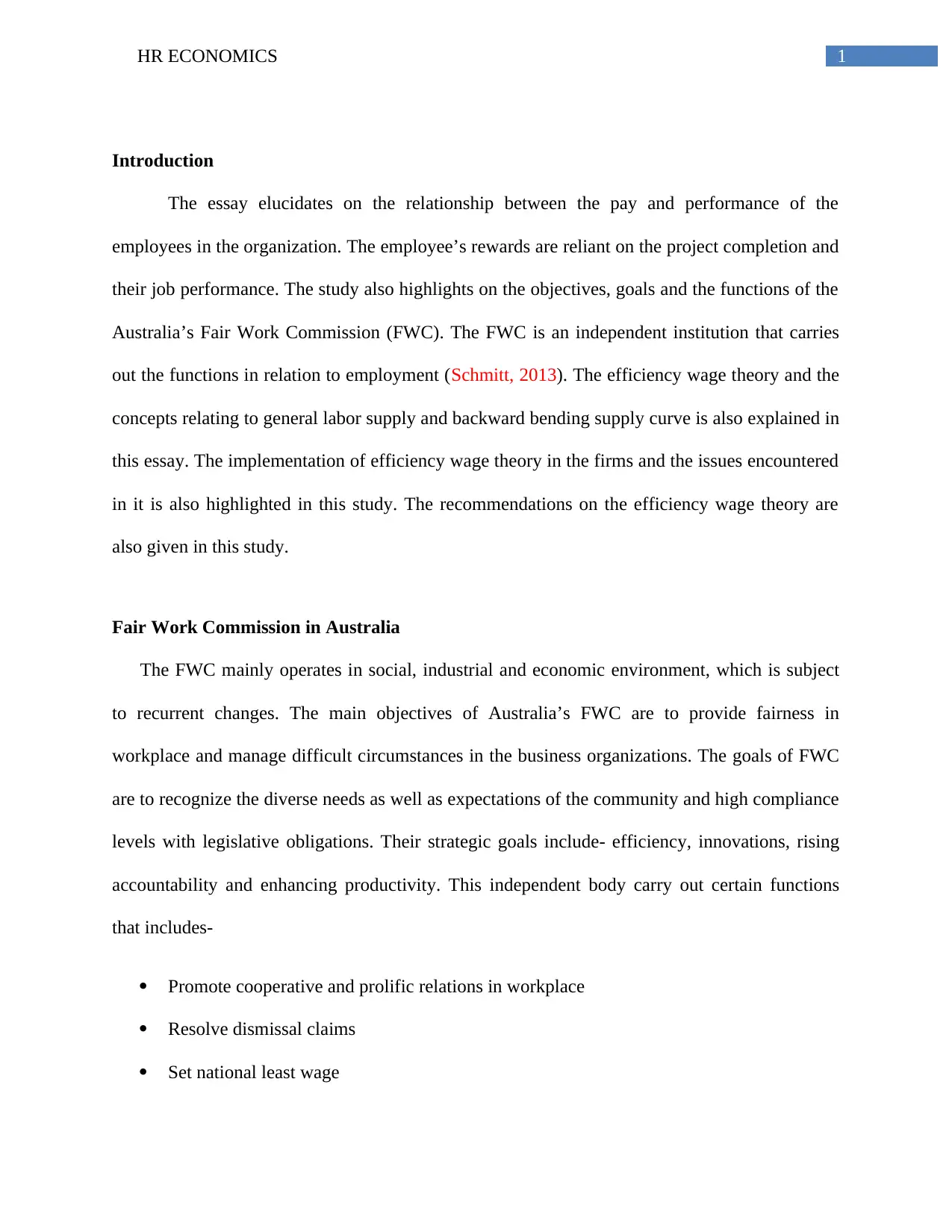
1HR ECONOMICS
Introduction
The essay elucidates on the relationship between the pay and performance of the
employees in the organization. The employee’s rewards are reliant on the project completion and
their job performance. The study also highlights on the objectives, goals and the functions of the
Australia’s Fair Work Commission (FWC). The FWC is an independent institution that carries
out the functions in relation to employment (Schmitt, 2013). The efficiency wage theory and the
concepts relating to general labor supply and backward bending supply curve is also explained in
this essay. The implementation of efficiency wage theory in the firms and the issues encountered
in it is also highlighted in this study. The recommendations on the efficiency wage theory are
also given in this study.
Fair Work Commission in Australia
The FWC mainly operates in social, industrial and economic environment, which is subject
to recurrent changes. The main objectives of Australia’s FWC are to provide fairness in
workplace and manage difficult circumstances in the business organizations. The goals of FWC
are to recognize the diverse needs as well as expectations of the community and high compliance
levels with legislative obligations. Their strategic goals include- efficiency, innovations, rising
accountability and enhancing productivity. This independent body carry out certain functions
that includes-
Promote cooperative and prolific relations in workplace
Resolve dismissal claims
Set national least wage
Introduction
The essay elucidates on the relationship between the pay and performance of the
employees in the organization. The employee’s rewards are reliant on the project completion and
their job performance. The study also highlights on the objectives, goals and the functions of the
Australia’s Fair Work Commission (FWC). The FWC is an independent institution that carries
out the functions in relation to employment (Schmitt, 2013). The efficiency wage theory and the
concepts relating to general labor supply and backward bending supply curve is also explained in
this essay. The implementation of efficiency wage theory in the firms and the issues encountered
in it is also highlighted in this study. The recommendations on the efficiency wage theory are
also given in this study.
Fair Work Commission in Australia
The FWC mainly operates in social, industrial and economic environment, which is subject
to recurrent changes. The main objectives of Australia’s FWC are to provide fairness in
workplace and manage difficult circumstances in the business organizations. The goals of FWC
are to recognize the diverse needs as well as expectations of the community and high compliance
levels with legislative obligations. Their strategic goals include- efficiency, innovations, rising
accountability and enhancing productivity. This independent body carry out certain functions
that includes-
Promote cooperative and prolific relations in workplace
Resolve dismissal claims
Set national least wage
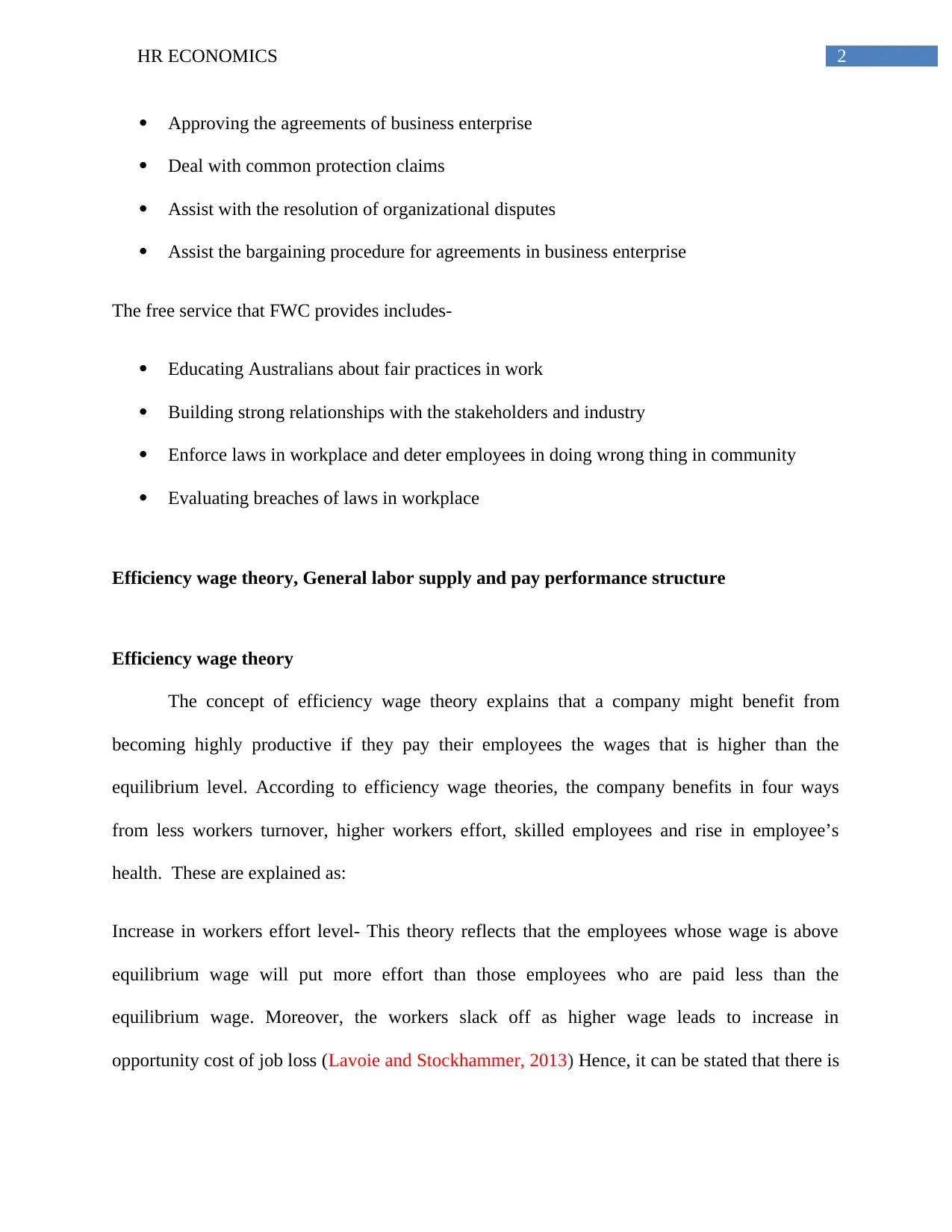
2HR ECONOMICS
Approving the agreements of business enterprise
Deal with common protection claims
Assist with the resolution of organizational disputes
Assist the bargaining procedure for agreements in business enterprise
The free service that FWC provides includes-
Educating Australians about fair practices in work
Building strong relationships with the stakeholders and industry
Enforce laws in workplace and deter employees in doing wrong thing in community
Evaluating breaches of laws in workplace
Efficiency wage theory, General labor supply and pay performance structure
Efficiency wage theory
The concept of efficiency wage theory explains that a company might benefit from
becoming highly productive if they pay their employees the wages that is higher than the
equilibrium level. According to efficiency wage theories, the company benefits in four ways
from less workers turnover, higher workers effort, skilled employees and rise in employee’s
health. These are explained as:
Increase in workers effort level- This theory reflects that the employees whose wage is above
equilibrium wage will put more effort than those employees who are paid less than the
equilibrium wage. Moreover, the workers slack off as higher wage leads to increase in
opportunity cost of job loss (Lavoie and Stockhammer, 2013) Hence, it can be stated that there is
Approving the agreements of business enterprise
Deal with common protection claims
Assist with the resolution of organizational disputes
Assist the bargaining procedure for agreements in business enterprise
The free service that FWC provides includes-
Educating Australians about fair practices in work
Building strong relationships with the stakeholders and industry
Enforce laws in workplace and deter employees in doing wrong thing in community
Evaluating breaches of laws in workplace
Efficiency wage theory, General labor supply and pay performance structure
Efficiency wage theory
The concept of efficiency wage theory explains that a company might benefit from
becoming highly productive if they pay their employees the wages that is higher than the
equilibrium level. According to efficiency wage theories, the company benefits in four ways
from less workers turnover, higher workers effort, skilled employees and rise in employee’s
health. These are explained as:
Increase in workers effort level- This theory reflects that the employees whose wage is above
equilibrium wage will put more effort than those employees who are paid less than the
equilibrium wage. Moreover, the workers slack off as higher wage leads to increase in
opportunity cost of job loss (Lavoie and Stockhammer, 2013) Hence, it can be stated that there is
⊘ This is a preview!⊘
Do you want full access?
Subscribe today to unlock all pages.

Trusted by 1+ million students worldwide

3HR ECONOMICS
a direct relationship between employees wages and their effort. The relationship between efforts
per employees is given as-
Ei= e[Wi/ We], where Ei= workers effort, Wi= Wage given by the company and We= Expected
existing wage outside firm.
Decline in employee’s turnover- This theory explains that the wage above equilibrium wage
decreases costly workers turnover. This explains that if the employees benefits outweigh cost ,
then they will choose to stay. Analogously, if business cost outweigh their benefits, then they
will choose to quit. However, if the workers turnover decreases, then some resources might freed
up and hence can be utilized in efficient processes.
Rise in workers quality- It suggests that efficiency wages will attract highly skilled employees in
the business. The entity will offer efficiency wage to high quality workers in order to retain them
in business (Shields et al., 2015). Thus, low quality workers will work for the equilibrium wage
as high quality workers demand higher wages from the company.
Improve in employee’s health- This explains that the employees who are paid higher wages will
improve their health and productivity. The reason behind this is that higher wage improves the
standard of living of the workers. However, this raises the employee’s quality of living, which
results in better health. This improve in worker’s health increases productive than those workers
who are paid less wages.
a direct relationship between employees wages and their effort. The relationship between efforts
per employees is given as-
Ei= e[Wi/ We], where Ei= workers effort, Wi= Wage given by the company and We= Expected
existing wage outside firm.
Decline in employee’s turnover- This theory explains that the wage above equilibrium wage
decreases costly workers turnover. This explains that if the employees benefits outweigh cost ,
then they will choose to stay. Analogously, if business cost outweigh their benefits, then they
will choose to quit. However, if the workers turnover decreases, then some resources might freed
up and hence can be utilized in efficient processes.
Rise in workers quality- It suggests that efficiency wages will attract highly skilled employees in
the business. The entity will offer efficiency wage to high quality workers in order to retain them
in business (Shields et al., 2015). Thus, low quality workers will work for the equilibrium wage
as high quality workers demand higher wages from the company.
Improve in employee’s health- This explains that the employees who are paid higher wages will
improve their health and productivity. The reason behind this is that higher wage improves the
standard of living of the workers. However, this raises the employee’s quality of living, which
results in better health. This improve in worker’s health increases productive than those workers
who are paid less wages.
Paraphrase This Document
Need a fresh take? Get an instant paraphrase of this document with our AI Paraphraser

4HR ECONOMICS
Figure 1: Efficiency Wage
There are various sub models of efficiency wage theories including -shirking model, fair wage-
effort model, adverse selection model and turnover model. These models of efficiency wage
assert that the workers productivity in the organization is directly related with the wages that the
workers receive. This sub- models is illustrated below:
Shirking model- This model highlights that higher wage paid to the worker increases the
risk of losing their job. However, the risk of shirking of employees reduces.
Figure 1: Efficiency Wage
There are various sub models of efficiency wage theories including -shirking model, fair wage-
effort model, adverse selection model and turnover model. These models of efficiency wage
assert that the workers productivity in the organization is directly related with the wages that the
workers receive. This sub- models is illustrated below:
Shirking model- This model highlights that higher wage paid to the worker increases the
risk of losing their job. However, the risk of shirking of employees reduces.

5HR ECONOMICS
Figure 1: Shirking Model
Fair wage-effort model- According to this model, if fair wage is not given to the
employees, then the workers do not give higher effort in their work.
Adverse selection model- In this case, if the wage to be paid to the workers is above the
equilibrium wage in the labor market, then it helps the entity in choosing better workers
from large pool.
Turnover model- This model reflects that if the wages paid to the workers is higher than
what they receive in other firms, then it will decrease the turnover in the entity. Thus, it
also reduces the coat of firms in hiring as well as training their workers.
Efficiency wage theory improving the performance of SG Company
Figure 1: Shirking Model
Fair wage-effort model- According to this model, if fair wage is not given to the
employees, then the workers do not give higher effort in their work.
Adverse selection model- In this case, if the wage to be paid to the workers is above the
equilibrium wage in the labor market, then it helps the entity in choosing better workers
from large pool.
Turnover model- This model reflects that if the wages paid to the workers is higher than
what they receive in other firms, then it will decrease the turnover in the entity. Thus, it
also reduces the coat of firms in hiring as well as training their workers.
Efficiency wage theory improving the performance of SG Company
⊘ This is a preview!⊘
Do you want full access?
Subscribe today to unlock all pages.

Trusted by 1+ million students worldwide

6HR ECONOMICS
The SG Company is one of the main driving factors of the Singapore economy. The efficiency
wage theory of this company has improved the firms performance. This means that as the SG
Company increased the pay of their employees, the total productivity in the business improved.
Although there has no changes in the responsibilities of their employees, implementation of new
technologies required the skills of their employees. However, the company strategized to hire
skilled employees by offering them higher pay. This strategy of utilization of skill-based pay as
well as knowledge- based pay improved their job performance. This organization has also
adopted flexible work pattern for improving productivity and save the cost of overtime. Even
they introduced a plan of paying their employees one and half times higher than basic pay rate of
employees who are working for overtime. The managers of this organization chose to pay
efficiency wage in order to avoid decrease in turnover, shirking and attract skilled workers.This
implementation of efficiency wage improved skills and productivity. This in turn improved the
firms performance and helped this company in expanding their business in global market.
General labor supply
Labor supply refers to the total work hours that the employees wishes to work at a
particular wage rate. Higher wages encourages the employees in supplying more labor as works
becomes more attractive in comparison to leisure (Burdett & Mortensen, 2012). Thus, the labor
supply curve becomes upward sloping. The factors that influences the workers labor supply
includes-
Substitution effect of increase in wages- Increase in wages will provide higher value to
employees work than leisure. If the work becomes more profitable, then it raises the
The SG Company is one of the main driving factors of the Singapore economy. The efficiency
wage theory of this company has improved the firms performance. This means that as the SG
Company increased the pay of their employees, the total productivity in the business improved.
Although there has no changes in the responsibilities of their employees, implementation of new
technologies required the skills of their employees. However, the company strategized to hire
skilled employees by offering them higher pay. This strategy of utilization of skill-based pay as
well as knowledge- based pay improved their job performance. This organization has also
adopted flexible work pattern for improving productivity and save the cost of overtime. Even
they introduced a plan of paying their employees one and half times higher than basic pay rate of
employees who are working for overtime. The managers of this organization chose to pay
efficiency wage in order to avoid decrease in turnover, shirking and attract skilled workers.This
implementation of efficiency wage improved skills and productivity. This in turn improved the
firms performance and helped this company in expanding their business in global market.
General labor supply
Labor supply refers to the total work hours that the employees wishes to work at a
particular wage rate. Higher wages encourages the employees in supplying more labor as works
becomes more attractive in comparison to leisure (Burdett & Mortensen, 2012). Thus, the labor
supply curve becomes upward sloping. The factors that influences the workers labor supply
includes-
Substitution effect of increase in wages- Increase in wages will provide higher value to
employees work than leisure. If the work becomes more profitable, then it raises the
Paraphrase This Document
Need a fresh take? Get an instant paraphrase of this document with our AI Paraphraser
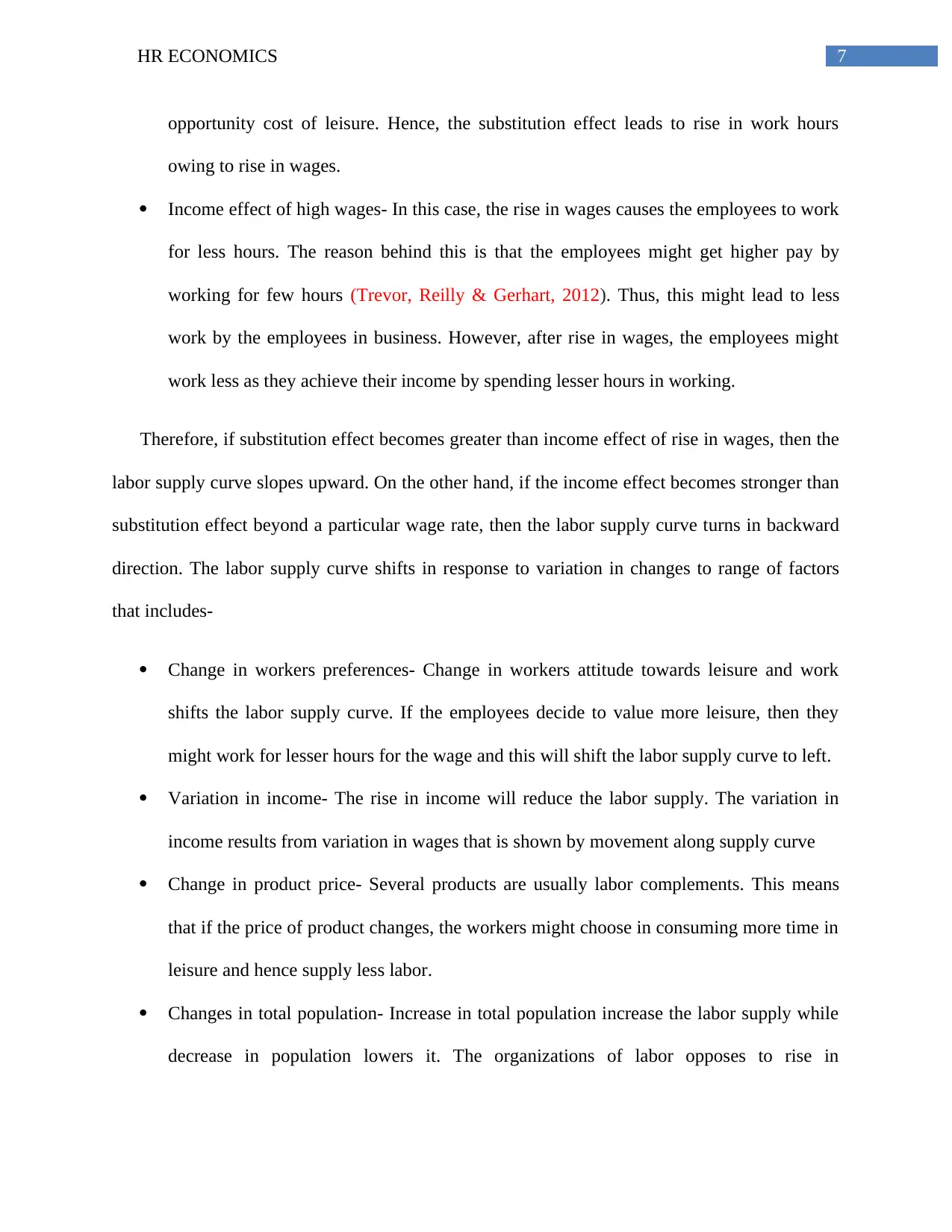
7HR ECONOMICS
opportunity cost of leisure. Hence, the substitution effect leads to rise in work hours
owing to rise in wages.
Income effect of high wages- In this case, the rise in wages causes the employees to work
for less hours. The reason behind this is that the employees might get higher pay by
working for few hours (Trevor, Reilly & Gerhart, 2012). Thus, this might lead to less
work by the employees in business. However, after rise in wages, the employees might
work less as they achieve their income by spending lesser hours in working.
Therefore, if substitution effect becomes greater than income effect of rise in wages, then the
labor supply curve slopes upward. On the other hand, if the income effect becomes stronger than
substitution effect beyond a particular wage rate, then the labor supply curve turns in backward
direction. The labor supply curve shifts in response to variation in changes to range of factors
that includes-
Change in workers preferences- Change in workers attitude towards leisure and work
shifts the labor supply curve. If the employees decide to value more leisure, then they
might work for lesser hours for the wage and this will shift the labor supply curve to left.
Variation in income- The rise in income will reduce the labor supply. The variation in
income results from variation in wages that is shown by movement along supply curve
Change in product price- Several products are usually labor complements. This means
that if the price of product changes, the workers might choose in consuming more time in
leisure and hence supply less labor.
Changes in total population- Increase in total population increase the labor supply while
decrease in population lowers it. The organizations of labor opposes to rise in
opportunity cost of leisure. Hence, the substitution effect leads to rise in work hours
owing to rise in wages.
Income effect of high wages- In this case, the rise in wages causes the employees to work
for less hours. The reason behind this is that the employees might get higher pay by
working for few hours (Trevor, Reilly & Gerhart, 2012). Thus, this might lead to less
work by the employees in business. However, after rise in wages, the employees might
work less as they achieve their income by spending lesser hours in working.
Therefore, if substitution effect becomes greater than income effect of rise in wages, then the
labor supply curve slopes upward. On the other hand, if the income effect becomes stronger than
substitution effect beyond a particular wage rate, then the labor supply curve turns in backward
direction. The labor supply curve shifts in response to variation in changes to range of factors
that includes-
Change in workers preferences- Change in workers attitude towards leisure and work
shifts the labor supply curve. If the employees decide to value more leisure, then they
might work for lesser hours for the wage and this will shift the labor supply curve to left.
Variation in income- The rise in income will reduce the labor supply. The variation in
income results from variation in wages that is shown by movement along supply curve
Change in product price- Several products are usually labor complements. This means
that if the price of product changes, the workers might choose in consuming more time in
leisure and hence supply less labor.
Changes in total population- Increase in total population increase the labor supply while
decrease in population lowers it. The organizations of labor opposes to rise in

8HR ECONOMICS
Hours Worked
Wage Rate
W2
W1
W
L L1 L2
immigration as increase in total number of employees shifts the labor supply curve in
rightward direction.
Variation in expectations- Variation in expectations will impact on the labor supply is
expectancy in life.
The backward bending supply curve of labor refers to the condition in which as the wages
rises beyond the particular level, then the employees substitute leisure with respect to their total
time in work. However, increase in wage leads to decline in supply of labor and hence less time
for labor has being offered for sale (Canto, Joines & Laffer, 2014). This contrast indicates that
higher wage tempt the employees to spend more hours in work for wage. Therefore, backward
bending supply curve of labor occurs when higher pay basically entice employees in working
less and consume high time for leisure.
Figure 1: Backward bending labor supply curve
Hours Worked
Wage Rate
W2
W1
W
L L1 L2
immigration as increase in total number of employees shifts the labor supply curve in
rightward direction.
Variation in expectations- Variation in expectations will impact on the labor supply is
expectancy in life.
The backward bending supply curve of labor refers to the condition in which as the wages
rises beyond the particular level, then the employees substitute leisure with respect to their total
time in work. However, increase in wage leads to decline in supply of labor and hence less time
for labor has being offered for sale (Canto, Joines & Laffer, 2014). This contrast indicates that
higher wage tempt the employees to spend more hours in work for wage. Therefore, backward
bending supply curve of labor occurs when higher pay basically entice employees in working
less and consume high time for leisure.
Figure 1: Backward bending labor supply curve
⊘ This is a preview!⊘
Do you want full access?
Subscribe today to unlock all pages.

Trusted by 1+ million students worldwide

9HR ECONOMICS
Source; (As created by author)
Pay performance structure
Pay for performance framework implies pay that is directly related to the performance of
an employee in meeting the objectives of the business. The managers of the specific business
frames performance goal to which the workers are held accountable (Gerhart, B., & Fang, M,
2014). The performance of the workers are mainly analyzed with the help of metrics that can be
either financial indicators or indirect indicators namely consumer satisfaction, development
speed etc. In addition, schemes for pay performance combines fixed salary with different pay
component, which varies with the performance of an individual. It has been stated by Fang, M.,
& Gerhart (2012), better performance of an employee will receive higher pay band while poor
performance of an individual will get low pay band. This pay for performance structure is also
termed as incentive pay.
Issues in firm while implementing efficiency wage and pay performance structure based on
this framework
In real world, this efficiency wage theory is sometimes not effective in maximizing profit
of the business organizations. The models of efficiency wage attempts in predicting the behavior
of the organizations and trade-off in the process of decision making. One thing that is common in
all efficiency wage framework is that if the wages paid to the workers are above the market
clearing level, then the production costs of the company’s increases that in turn generates
involuntary unemployment.
Source; (As created by author)
Pay performance structure
Pay for performance framework implies pay that is directly related to the performance of
an employee in meeting the objectives of the business. The managers of the specific business
frames performance goal to which the workers are held accountable (Gerhart, B., & Fang, M,
2014). The performance of the workers are mainly analyzed with the help of metrics that can be
either financial indicators or indirect indicators namely consumer satisfaction, development
speed etc. In addition, schemes for pay performance combines fixed salary with different pay
component, which varies with the performance of an individual. It has been stated by Fang, M.,
& Gerhart (2012), better performance of an employee will receive higher pay band while poor
performance of an individual will get low pay band. This pay for performance structure is also
termed as incentive pay.
Issues in firm while implementing efficiency wage and pay performance structure based on
this framework
In real world, this efficiency wage theory is sometimes not effective in maximizing profit
of the business organizations. The models of efficiency wage attempts in predicting the behavior
of the organizations and trade-off in the process of decision making. One thing that is common in
all efficiency wage framework is that if the wages paid to the workers are above the market
clearing level, then the production costs of the company’s increases that in turn generates
involuntary unemployment.
Paraphrase This Document
Need a fresh take? Get an instant paraphrase of this document with our AI Paraphraser
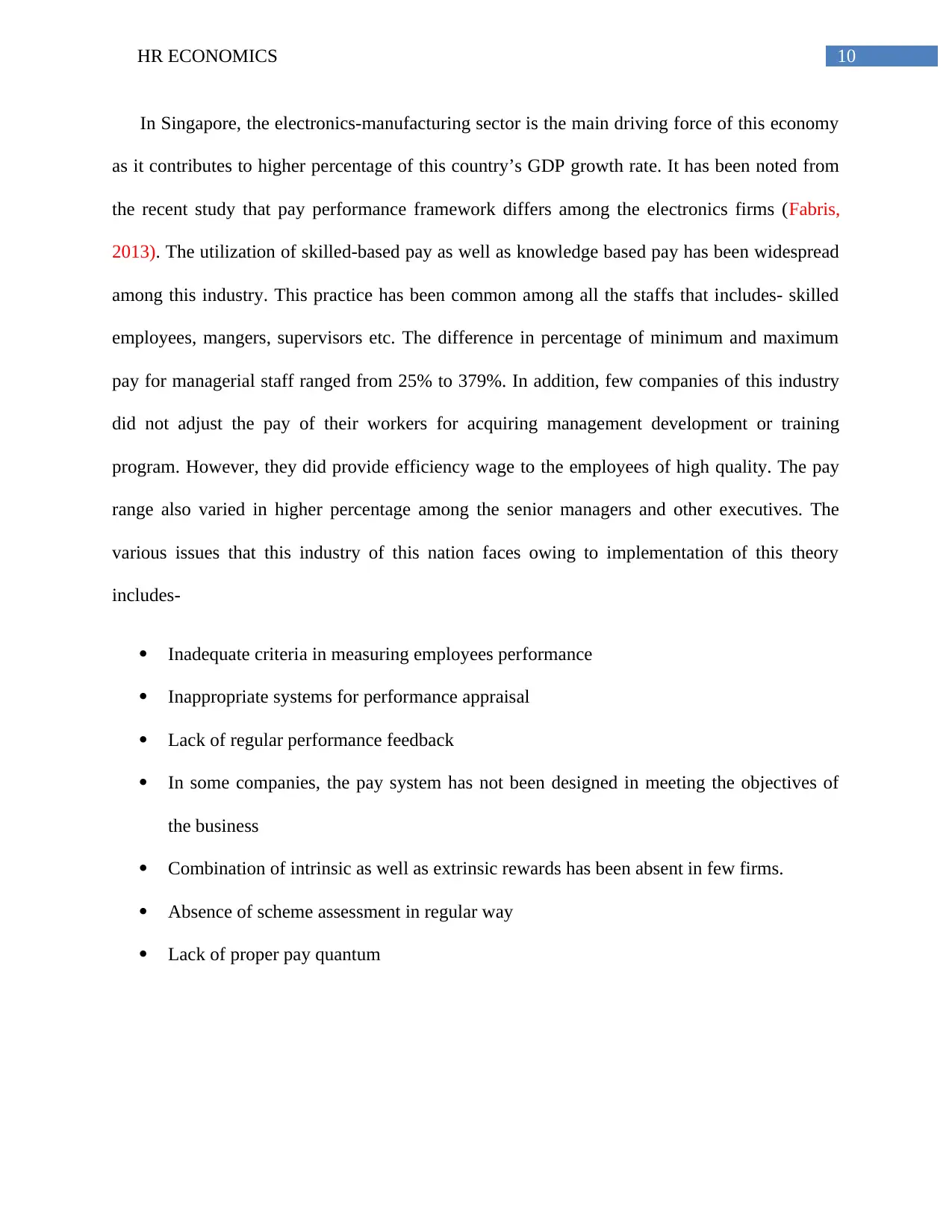
10HR ECONOMICS
In Singapore, the electronics-manufacturing sector is the main driving force of this economy
as it contributes to higher percentage of this country’s GDP growth rate. It has been noted from
the recent study that pay performance framework differs among the electronics firms (Fabris,
2013). The utilization of skilled-based pay as well as knowledge based pay has been widespread
among this industry. This practice has been common among all the staffs that includes- skilled
employees, mangers, supervisors etc. The difference in percentage of minimum and maximum
pay for managerial staff ranged from 25% to 379%. In addition, few companies of this industry
did not adjust the pay of their workers for acquiring management development or training
program. However, they did provide efficiency wage to the employees of high quality. The pay
range also varied in higher percentage among the senior managers and other executives. The
various issues that this industry of this nation faces owing to implementation of this theory
includes-
Inadequate criteria in measuring employees performance
Inappropriate systems for performance appraisal
Lack of regular performance feedback
In some companies, the pay system has not been designed in meeting the objectives of
the business
Combination of intrinsic as well as extrinsic rewards has been absent in few firms.
Absence of scheme assessment in regular way
Lack of proper pay quantum
In Singapore, the electronics-manufacturing sector is the main driving force of this economy
as it contributes to higher percentage of this country’s GDP growth rate. It has been noted from
the recent study that pay performance framework differs among the electronics firms (Fabris,
2013). The utilization of skilled-based pay as well as knowledge based pay has been widespread
among this industry. This practice has been common among all the staffs that includes- skilled
employees, mangers, supervisors etc. The difference in percentage of minimum and maximum
pay for managerial staff ranged from 25% to 379%. In addition, few companies of this industry
did not adjust the pay of their workers for acquiring management development or training
program. However, they did provide efficiency wage to the employees of high quality. The pay
range also varied in higher percentage among the senior managers and other executives. The
various issues that this industry of this nation faces owing to implementation of this theory
includes-
Inadequate criteria in measuring employees performance
Inappropriate systems for performance appraisal
Lack of regular performance feedback
In some companies, the pay system has not been designed in meeting the objectives of
the business
Combination of intrinsic as well as extrinsic rewards has been absent in few firms.
Absence of scheme assessment in regular way
Lack of proper pay quantum
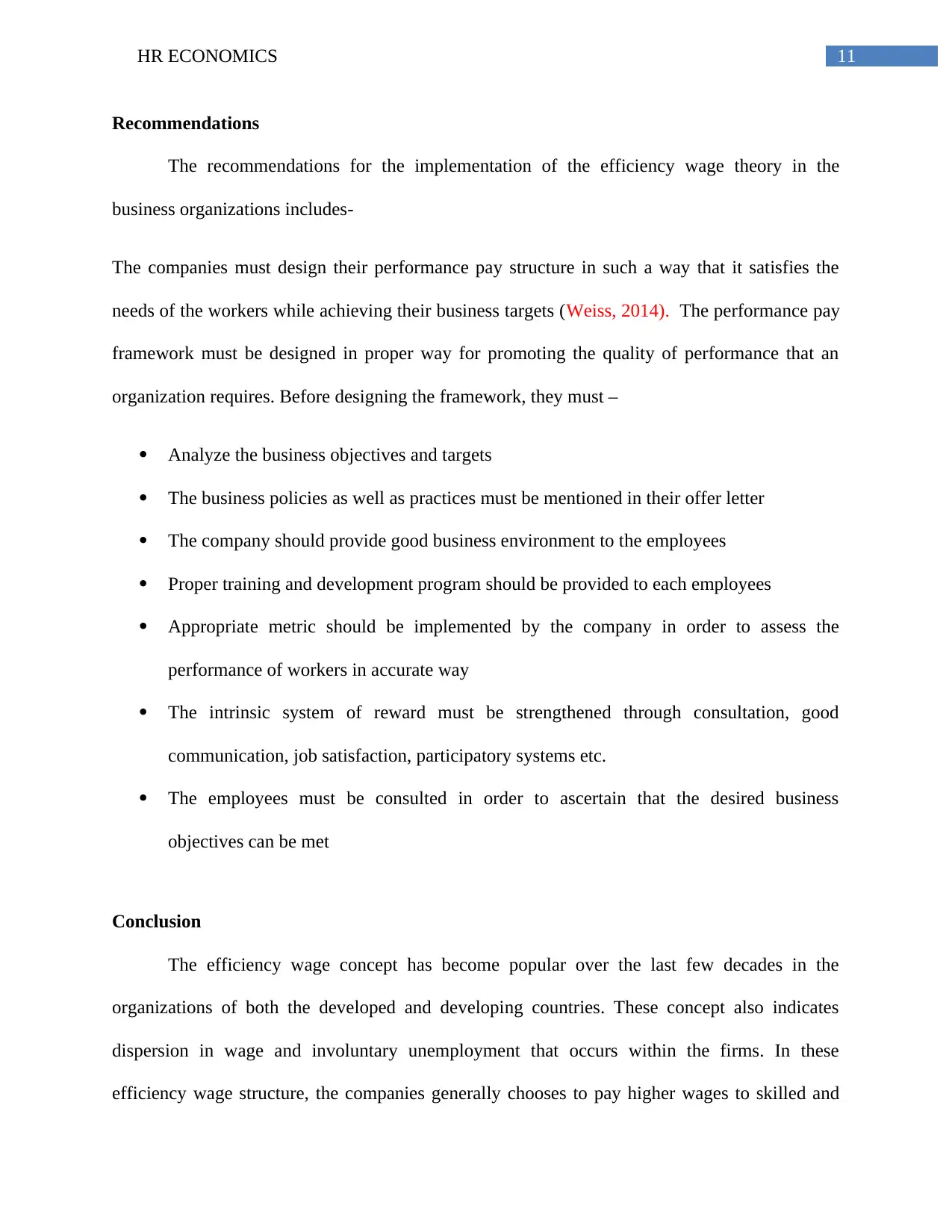
11HR ECONOMICS
Recommendations
The recommendations for the implementation of the efficiency wage theory in the
business organizations includes-
The companies must design their performance pay structure in such a way that it satisfies the
needs of the workers while achieving their business targets (Weiss, 2014). The performance pay
framework must be designed in proper way for promoting the quality of performance that an
organization requires. Before designing the framework, they must –
Analyze the business objectives and targets
The business policies as well as practices must be mentioned in their offer letter
The company should provide good business environment to the employees
Proper training and development program should be provided to each employees
Appropriate metric should be implemented by the company in order to assess the
performance of workers in accurate way
The intrinsic system of reward must be strengthened through consultation, good
communication, job satisfaction, participatory systems etc.
The employees must be consulted in order to ascertain that the desired business
objectives can be met
Conclusion
The efficiency wage concept has become popular over the last few decades in the
organizations of both the developed and developing countries. These concept also indicates
dispersion in wage and involuntary unemployment that occurs within the firms. In these
efficiency wage structure, the companies generally chooses to pay higher wages to skilled and
Recommendations
The recommendations for the implementation of the efficiency wage theory in the
business organizations includes-
The companies must design their performance pay structure in such a way that it satisfies the
needs of the workers while achieving their business targets (Weiss, 2014). The performance pay
framework must be designed in proper way for promoting the quality of performance that an
organization requires. Before designing the framework, they must –
Analyze the business objectives and targets
The business policies as well as practices must be mentioned in their offer letter
The company should provide good business environment to the employees
Proper training and development program should be provided to each employees
Appropriate metric should be implemented by the company in order to assess the
performance of workers in accurate way
The intrinsic system of reward must be strengthened through consultation, good
communication, job satisfaction, participatory systems etc.
The employees must be consulted in order to ascertain that the desired business
objectives can be met
Conclusion
The efficiency wage concept has become popular over the last few decades in the
organizations of both the developed and developing countries. These concept also indicates
dispersion in wage and involuntary unemployment that occurs within the firms. In these
efficiency wage structure, the companies generally chooses to pay higher wages to skilled and
⊘ This is a preview!⊘
Do you want full access?
Subscribe today to unlock all pages.

Trusted by 1+ million students worldwide
1 out of 14
Related Documents
Your All-in-One AI-Powered Toolkit for Academic Success.
+13062052269
info@desklib.com
Available 24*7 on WhatsApp / Email
![[object Object]](/_next/static/media/star-bottom.7253800d.svg)
Unlock your academic potential
Copyright © 2020–2025 A2Z Services. All Rights Reserved. Developed and managed by ZUCOL.





